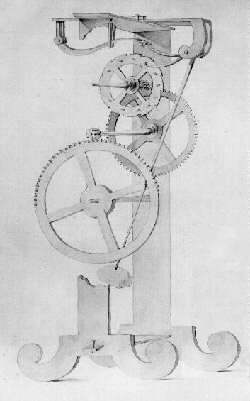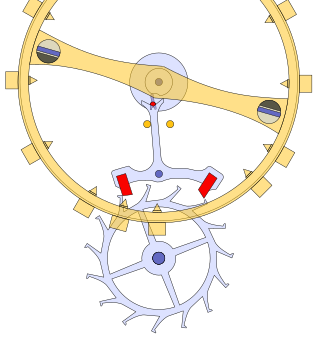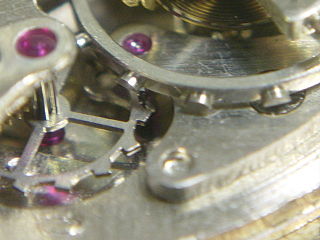
John Harrison was an English carpenter and clockmaker who invented the marine chronometer, a long-sought-after device for solving the problem of calculating longitude while at sea.

A pendulum clock is a clock that uses a pendulum, a swinging weight, as its timekeeping element. The advantage of a pendulum for timekeeping is that it is an approximate harmonic oscillator: It swings back and forth in a precise time interval dependent on its length, and resists swinging at other rates. From its invention in 1656 by Christiaan Huygens, inspired by Galileo Galilei, until the 1930s, the pendulum clock was the world's most precise timekeeper, accounting for its widespread use. Throughout the 18th and 19th centuries, pendulum clocks in homes, factories, offices, and railroad stations served as primary time standards for scheduling daily life, work shifts, and public transportation. Their greater accuracy allowed for the faster pace of life which was necessary for the Industrial Revolution. The home pendulum clock was replaced by less-expensive synchronous electric clocks in the 1930s and '40s. Pendulum clocks are now kept mostly for their decorative and antique value.

An escapement is a mechanical linkage in mechanical watches and clocks that gives impulses to the timekeeping element and periodically releases the gear train to move forward, advancing the clock's hands. The impulse action transfers energy to the clock's timekeeping element to replace the energy lost to friction during its cycle and keep the timekeeper oscillating. The escapement is driven by force from a coiled spring or a suspended weight, transmitted through the timepiece's gear train. Each swing of the pendulum or balance wheel releases a tooth of the escapement's escape wheel, allowing the clock's gear train to advance or "escape" by a fixed amount. This regular periodic advancement moves the clock's hands forward at a steady rate. At the same time, the tooth gives the timekeeping element a push, before another tooth catches on the escapement's pallet, returning the escapement to its "locked" state. The sudden stopping of the escapement's tooth is what generates the characteristic "ticking" sound heard in operating mechanical clocks and watches.

In horology, a movement, also known as a caliber or calibre, is the mechanism of a watch or timepiece, as opposed to the case, which encloses and protects the movement, and the face, which displays the time. The term originated with mechanical timepieces, whose clockwork movements are made of many moving parts. The movement of a digital watch is more commonly known as a module.

In horology, the anchor escapement is a type of escapement used in pendulum clocks. The escapement is a mechanism in a mechanical clock that maintains the swing of the pendulum by giving it a small push each swing, and allows the clock's wheels to advance a fixed amount with each swing, moving the clock's hands forward. The anchor escapement was so named because one of its principal parts is shaped vaguely like a ship's anchor.

The vergeescapement is the earliest known type of mechanical escapement, the mechanism in a mechanical clock that controls its rate by allowing the gear train to advance at regular intervals or 'ticks'. Verge escapements were used from the late 13th century until the mid 19th century in clocks and pocketwatches. The name verge comes from the Latin virga, meaning stick or rod.

The pallet fork is a component of the lever escapement of a mechanical watch. The pallet fork and the lever form one component that sits between the escape wheel and the balance wheel. Its purpose is to lock the escape wheel, and release it one tooth at a time at each swing of the balance wheel, and also give the balance wheel small pushes to keep it going.

John Arnold was an English watchmaker and inventor.

The lever escapement, invented by the English clockmaker Thomas Mudge in 1754, is a type of escapement that is used in almost all mechanical watches, as well as small mechanical non-pendulum clocks, alarm clocks, and kitchen timers.

A Roskopf, pin-lever, or pin-pallet escapement is an inexpensive, less accurate version of the lever escapement, used in mechanical alarm clocks, kitchen timers, mantel clocks and, until the 1970s, cheap watches now known as pin lever watches. It was popularized by German watchmaker Georges Frederic Roskopf in its "proletarian watch" from 1867. It was invented by Louis Perron, of Besançon, suggested to Roskopf by Jules Grossmann.

A balance spring, or hairspring, is a spring attached to the balance wheel in mechanical timepieces. It causes the balance wheel to oscillate with a resonant frequency when the timepiece is running, which controls the speed at which the wheels of the timepiece turn, thus the rate of movement of the hands. A regulator lever is often fitted, which can be used to alter the free length of the spring and thereby adjust the rate of the timepiece.

A torsion pendulum clock, more commonly known as an anniversary clock or 400-day clock, is a mechanical clock which keeps time with a mechanism called a torsion pendulum. This is a weighted disk or wheel, often a decorative wheel with three or four chrome balls on ornate spokes, suspended by a thin wire or ribbon called a torsion spring. The torsion pendulum rotates about the vertical axis of the wire, twisting it, instead of swinging like an ordinary pendulum. The force of the twisting torsion spring reverses the direction of rotation, so the torsion pendulum oscillates slowly, clockwise and counterclockwise. The clock's gears apply a pulse of torque to the top of the torsion spring with each rotation to keep the wheel going. The Atmos Clock made by the Swiss company Jaeger-LeCoultre is another style of this clock. The wheel and torsion spring function similarly to a watch's balance wheel and hairspring, as a harmonic oscillator to control the rate of the clock's hands.

The Riefler escapement is a mechanical escapement for precision pendulum clocks invented and patented by German instrument maker Sigmund Riefler in 1889. It was used in the astronomical regulator clocks made by his German firm Clemens Riefler from 1890 to 1965, which were perhaps the most accurate all-mechanical pendulum clocks made.

A turret clock or tower clock is a clock designed to be mounted high in the wall of a building, usually in a clock tower, in public buildings such as churches, university buildings, and town halls. As a public amenity to enable the community to tell the time, it has a large face visible from far away, and often a striking mechanism which rings bells upon the hours.

A mechanical watch is a watch that uses a clockwork mechanism to measure the passage of time, as opposed to quartz watches which function using the vibration modes of a piezoelectric quartz tuning fork, or radio watches, which are quartz watches synchronized to an atomic clock via radio waves. A mechanical watch is driven by a mainspring which must be wound either periodically by hand or via a self-winding mechanism. Its force is transmitted through a series of gears to power the balance wheel, a weighted wheel which oscillates back and forth at a constant rate. A device called an escapement releases the watch's wheels to move forward a small amount with each swing of the balance wheel, moving the watch's hands forward at a constant rate. The escapement is what makes the 'ticking' sound which is heard in an operating mechanical watch. Mechanical watches evolved in Europe in the 17th century from spring powered clocks, which appeared in the 15th century.

A marine chronometer is a precision timepiece that is carried on a ship and employed in the determination of the ship's position by celestial navigation. It is used to determine longitude by comparing Greenwich Mean Time (GMT), and the time at the current location found from observations of celestial bodies. When first developed in the 18th century, it was a major technical achievement, as accurate knowledge of the time over a long sea voyage was vital for effective navigation, lacking electronic or communications aids. The first true chronometer was the life work of one man, John Harrison, spanning 31 years of persistent experimentation and testing that revolutionized naval navigation.
Edward Martin Burgess FSA FBHI, known as Martin Burgess, was an English horologist and master clockmaker.

The Shortt–Synchronome free pendulum clock is a complex precision electromechanical pendulum clock invented in 1921 by British railway engineer William Hamilton Shortt in collaboration with horologist Frank Hope-Jones, and manufactured by the Synchronome Company, Ltd., of London. They were the most accurate pendulum clocks ever commercially produced, and became the highest standard for timekeeping between the 1920s and the 1940s, after which mechanical clocks were superseded by quartz time standards. They were used worldwide in astronomical observatories, naval observatories, in scientific research, and as a primary standard for national time dissemination services. The Shortt was the first clock to be a more accurate timekeeper than the Earth itself; it was used in 1926 to detect tiny seasonal changes in the Earth's rotation rate. Shortt clocks achieved accuracy of around a second per year, although a recent measurement indicated they were even more accurate. About 100 were produced between 1922 and 1956.
In horology, a wheel train is the gear train of a mechanical watch or clock. Although the term is used for other types of gear trains, the long history of mechanical timepieces has created a traditional terminology for their gear trains which is not used in other applications of gears.
David Robertson was the first Professor of Electrical Engineering at Bristol University. Robertson had wide interests and one of these was horology – he wanted to provide the foundation of what we could call “horological engineering”, that is, a firm science-based approach to the design of accurate mechanical clocks. He contributed a long series on the scientific foundations of precision clocks to the Horological Journal which was the main publication for the trade in the UK; he and his students undertook research on clocks and pendulums ; and he designed at least one notable clock, to keep University time and control the chiming of Great George in the Wills Memorial Building from its inauguration on 1925, for which he also designed the chiming mechanism.

















